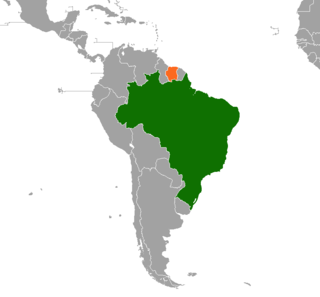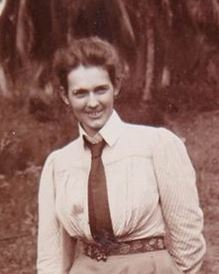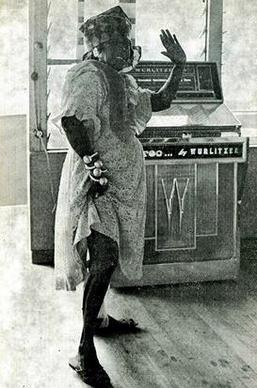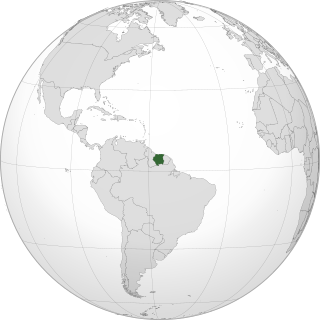
Suriname, officially the Republic of Suriname, is a country in northern South America, sometimes considered part of the Caribbean and the West Indies. Situated slightly north of the equator, over 90% of its territory is covered by rainforests, the highest proportion of forest cover in the world. Suriname is bordered by the Atlantic Ocean to the north, French Guiana to the east, Guyana to the west, and Brazil to the south. It is the smallest country in South America by both population and territory, with around 612,985 inhabitants in an area of approximately 163,820 square kilometers. The capital and largest city is Paramaribo, which is home to roughly half the population.
The early history of Suriname dates from 3000 BCE when Native Americans first inhabited the area. The Dutch acquired Suriname from the English, and European settlement in any numbers dates from the 17th century, when it was a plantation colony utilizing slavery for sugar cultivation. With abolition in the late 19th century, planters sought labor from China, Madeira, India, and Indonesia, which was also colonized by the Dutch. Dutch is Suriname's official language. Owing to its diverse population, it has also developed a creole language, Sranan Tongo.
Sranan Tongo is an English-based creole language that is spoken as a lingua franca by approximately 519,600 people in Suriname.

Moengo is a town in Suriname, located in the Marowijne district, between Paramaribo and the border town Albina on the Cottica River. Moengo is also a resort (municipality) in the district of Marowijne. Moengo was the capital of Marowijne District between 1932 and 1945. The current capital is Albina.
Indo-Surinamese, Indian-Surinamese or Hindustani Surinamese are nationals of Suriname of Indian origin, who trace their ancestry to India and the wider subcontinent. Their ancestors were indentured workers from British Raj brought by the Dutch and the British to the (then) Dutch colony of Suriname during the mid-19th to the early 20th century. Per the 2012 Census of Suriname, 148,443 citizens of Suriname are of Indo-Surinamese origin, constituting 27.4% of the total population, making them the largest ethnic group in Suriname on an individual level.

According to the official data, the Muslim population of Suriname represents about 13.9 percent of the country's total population as of 2012, which is the highest percentage of Muslims in the Americas. Though the majority belong to the Sunni sect of Islam, there are some Shi'a, and a small population of Ahmadiyyas.

Surinamese people are people who identify with the country of Suriname. This connection may be residential, legal, historical or cultural. For most Surinamese, several of these connections exist and are collectively the source of their being Surinamese.
Susanna du Plessis (1739–1795) was a plantation owner in Dutch Surinam. She is a legendary figure in the history of Surinam, where she probably unjustely has become a metaphor of a cruel and sadistic slave owner. She is the subject of songs, plays, fairy tales and legends as well as books.
Chinese Surinamese people are Surinamese residents of ethnic Han Chinese origin. The earliest migrants came in the 19th century as indentured laborers; there was another wave of migration in the 1950s and 1960s. There were 7,885 Chinese in Suriname at the 2012 census, constituting 1.5% of the total population. They constitute the largest component of the 'other' ethnic category, which makes up 2.3% of the population as per the CIA World Factbook. The majority of the Chinese Surinamese consider Hakka of Guangdong as their ancestral homes. There is a small minority of Heshan, Jiangmen origin Cantonese and Hakkas as well.

Surinamese culture has strong Asian, African and European influences. The population is mainly composed of the contribution of people from India, Africa, China, Europe, and Indonesia, as well as indigenous peoples who lived in the area, before the arrival of European settlers.

Surinam, also unofficially known as Dutch Guiana, was a Dutch plantation colony in the Guianas, bordered by the equally Dutch colony of Berbice to the west, and the French colony of Cayenne to the east. It later bordered British Guiana from 1831 to 1966.

Brazil–Suriname relations are the bilateral relations between the Federative Republic of Brazil and the Republic of Suriname. Diplomatic relations were established on 3 March 1976. Brazil has an embassy in Paramaribo since the independence of Suriname on 25 November 1975. Suriname has an embassy in Brasília since 1976, and a consulate in Belém since 2012.

The Lawa Railway was a 173-kilometre-long single-track metre gauge railway in Suriname. It was built during the gold rush in the early 20th century, from the harbour town Paramaribo to Dam at the Sara Creek, but it was not extended to the gold fields at the Lawa River, as originally intended.
Cannabis in Suriname is illegal. Cannabis is the most popular illegal drug in Suriname.

Salikin Mardi Hardjo was a Javanese-Surinamese social activist born in Malang, Jawa Timur, Indonesia. He is known for his opposition to Dutch colonial rule in Suriname in the 1930s, advocacy for the Javanese community in Suriname, and their perceived marginalisation and orchestrating the repatriation of many Javanese-Surinamese to Tongar in West Sumatra near Padang.

Grace Schneiders-Howard was a Surinamese social worker and politician. Initially beginning her career in civil service as an agent for immigrant workers, she later worked in the Hygiene Department to develop sanitation services in the country. When women were allowed to run for office, but without the right to vote, she ran as a candidate for the Estates of Suriname. Elected in 1938, she became the first woman to serve in the Surinamese legislature. A controversial and abrasive figure, Schneiders-Howard was convinced of her own racial and social superiority, using her work with migrants and the poor to propel her own aims and views of how society should be organized. A pioneer woman in many fields, she was condemned by her opponents, who questioned her morals, her motivations and even her sanity. Her lasting impact was upon bringing improved sanitation of the country.

Maxi Linder the alias used by Wilhelmina Rijburg (1902–1981) was a well-known and influential Surinamese prostitute. In her heyday, she had access to the highest social and political figures. She used her earnings to fund the education of disadvantaged youth and made the first attempt in the country to organize sex workers.

Nola Hatterman was a Dutch actress and painter.

Squatting in Suriname is the occupation of unused land or derelict buildings without the permission of the owner. Maroons and indigenous peoples such as Tiriyó Amerindians have squatted buildings and illegal gold prospectors have occupied land.














